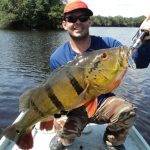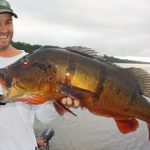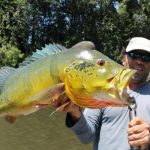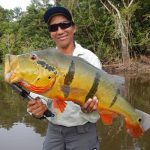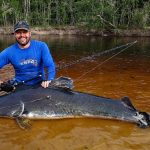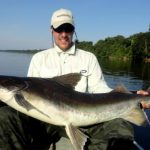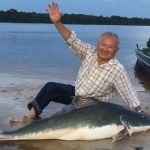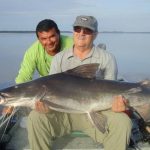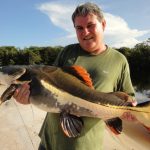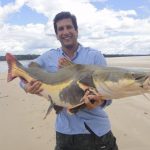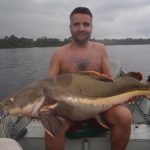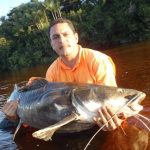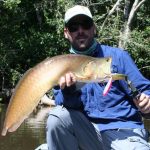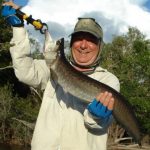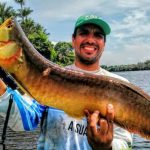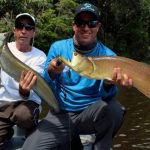THE AMAZON – RIO NEGRO RIVER
More than 450 different species of fish have been recorded in the Rio Negro river. That’s 15 times the total of species in all the rivers of Europe. Considered the world’s fourth-largest river, the Rio Negro spans more than 625 miles. Though its tannin-rich waters are the color of strong tea, the river runs amazingly clear (not muddy). The current all-tackle world-record speckled peacock bass (Cichla temensis) was caught in this river, near the town of Barcelos, and the 27-pound fish represents a goal for many avid anglers. Among an enormous fish variety found in the Amazon rivers, the 4 most popular fish species found in the Rio Negro river and its streams are the Peacock Bass, Arowana, Redtail Catfish and the Piraiba.
![]() Peacock Bass (Cichla Temensis) Tucunaré
Peacock Bass (Cichla Temensis) Tucunaré
Called Brazil’s aquatic ambassador because of its popularity among international sport fishermen, several different species of peacocks inhabit the Amazon river system. Speckled peacocks are the largest members of the family, growing to more than 25 pounds. Coloration varies and may include several black vertical bands on the body, or horizontal rows of yellowish spots and dashes over golden-green flanks. Peacocks prefer bays and lagoons off main river channels, especially near fallen trees and other structure, and sometimes roam in large schools and attack baitfish in feeding frenzies. The largest fish are found in the Madeira and Rio Negro regions. The current world record peacock (27 pounds) was taken from the Rio Negro. Live-baiting, trolling and plugcasting all work well, but most sport fishermen prefer plugcasting or flyfishing for peacocks. For lure fishing, use medium-heavy casting rods and 16- to 25-pound line or even heavier superbraid. Diving plugs are effective, but topwater lures offer much more excitement and heart-stopping strikes. Fly fishermen should use 8-weight outfits and WF floating lines with poppers as well as intermediate-sink lines and streamers.
![]() Piraíba (Brachyplatystoma Filamentosum)
Piraíba (Brachyplatystoma Filamentosum)
Residents of the Amazon region call catfish “smooth fish,” and call the really big ones “beasts.” In this world, the piraiba rules as one of the world’s largest freshwater species. It doesn’t settle in deep pools, so look for this beast near rapids and below waterfalls where it hunts smaller fish; or find it in the main river channel, in deep stretches with minimal current flow. Rivers such as the Telles Pires, Juruena and Madeira offer the best chances of hooking piraiba. Fish with a buddy in a stable boat, and be ready to release the anchor line to chase a hooked fish. The piraiba’s strike and fight are incredibly strong, as is its endurance. Use very heavy tackle, lines rated for 80 pounds or more, and rods that can cast baits weighing up to a pound. Hooks (size 10/0 and larger) should be rigged on wire leaders. Live bait gets the best results.
![]() Redtail Catfish (Phractocephalus Hemioliopterus) Pirarara
Redtail Catfish (Phractocephalus Hemioliopterus) Pirarara
Always a contender among the Amazon’s heavyweights, these beautifully colored cats were called “macaw fish” by the Indians. They can grow to 5 feet and weigh more than 120 pounds. Larger fish prefer the deepest pools and put up a long, strong fight when hooked. At the end of the fight, redtails often emit a loud wheezing sound when they come to the surface, which can frighten unsuspecting anglers. They take a wide range of baits such as small fish or cut bait; the best choice varies by region. Redtails occur throughout the Amazon basin but seem to grow largest in the Guapore, Telles Pires, Juruena and Madeira rivers. To tame these beasts, anglers need heavy tackle, 50-pound line and 5/0 to 8/0 hooks on wire leaders.
![]() Arowana (Oteoglossum Bicirrhosum) Aruanã
Arowana (Oteoglossum Bicirrhosum) Aruanã
This uniquely shaped fish is the only scaled fish to have barbels on the lower jaw. Two subspecies exist: one is copper-colored and can grow to more than 3 feet and the other, smaller and darker, occurs only in the Rio Negro. Adults protect young by taking them into their mouth. Arowana have excellent above-water vision and often jump high to pick insects off overhanging branches. They also eat small fish and other aquatic creatures. The arowana’s narrow, hard mouth makes it difficult to hook, and the fish often misses lures when striking wildly at them. Use medium casting tackle and 16-pound line, diving and topwater lures, or 7-weight fly rods with streamers and poppers.
SOME OTHER FISH SPECIES YOU CAN CATCH IN THE AMAZON
Jatuarana (Hemiodus microcephalus) and Matrincha (Brycon melanopterus)

These two similar yet distinct species often fool anglers as to their identity. Jatuarana are golden-yellow with a black mark covering much of the tail fin and can grow to 16 pounds. They are most active when rivers have a strong flow, favoring rocky areas and large pools below rapids, where they dart out to grab prey in fast current. Anglers know when they hook a jatuarana because these fish jump immediately and make strong downriver runs. One of the best spots to find them is in the Pau Cerne river, a tributary of the Guapore. The matrincha is smaller, rarely exceeding 8 pounds, with a silvery body. They are more common but just as difficult to hook. Clear, fast-flowing rivers such as the Von den Steinen are ideal for matrincha. Look for them near overhanging trees and brushpiles. For both species, use medium tackle and 16- to 20-pound line, spoons and spinners.
Sorubim – Cachara
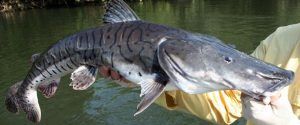
Several members of the Pseudoplatystoma family, such as the tiger sorubim, live in these waters and go by different common names such as pintado, cachara and caparari. Their delicious flesh makes them highly prized by sport fishermen as well as local meat fishermen. They tend to nibble lightly before taking a bait, then head for the cover of snags and brushpiles. Find these flat-headed cats in deep pools, at river bends, near floating pads of vegetation and along sandbars. Use heavy tackle and 30- to 50-pound line with 8/0 or larger hooks on steel leaders. Natural baits such as large worms, small fish and eels work best. Sorubim are most active early and late in the day, during low-light hours, and at night.
Gilded Catfish (Brachyplatystoma flavicans)
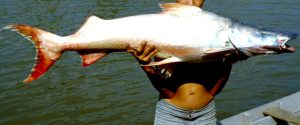
This cousin of the piraiba has a narrower body and an overall golden coloration. It occurs in good numbers in the Madeira River. Gilded cats prefer stretches of slow current and take baits consisting of whole fish or chunks. Heavy tackle is necessary for these brutes, with 30- to 50-pound line and 5/0 to 8/0 hooks on wire leaders.
Pirarucu (Arapaima gigas)
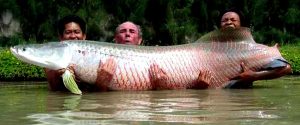
Range: Amazon and Araguaia watersheds
Characteristics: The world’s largest scaled fish can grow to more than 7 feet and 300 pounds. Small head, cylindrical body covered with large scales, coloration mostly copper-bronze with creamy belly, some bright red accents along body. Comes to the surface at regular intervals to gulp air.
Diet: small fish, crustaceans and amphibians
Habitat: shallow bays and still waters.
Tackle: heavy rods and 50-lb line or heavier; large circle hooks baited with small fish
Tambaqui (Colossoma macrapomum)
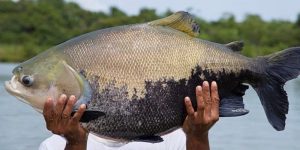
Among Brazil’s largest scaled freshwater fish, tambaqui can exceed 4 feet and weigh more than 60 pounds. The round, laterally compressed body is dark green on the back, white on the underside and darkening to black near the tail. During high-water season, it enters flooded forests to feed on fruits and seeds. Not a common sport-fishing target, tambaqui are often hard to locate and harder to hook and land due to their brute strength. Use heavy tackle, 40-pound or stronger line and 5/0 to 7/0 hookss baited with worms or fruit. The Guapore and Madeira rivers offer the best chances to locate and catch tambaqui.
Payara (Hydrolicus scomberoides) Cachorra
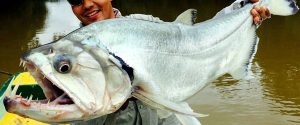
Range: Amazon and Paraguay river basins
Characteristics: Known as cachorra (dogfish) in Brazil, the payara prefers fast-moving stretches of rivers throughout the Amazon and Paraguay river watersheds. The elongated, compressed body is dark blue or greenish along the back, brightening to silver sides and white belly. Easily identified by a pair of long fangs in the lower jaw, payara are voracious predators that attack artificial lures and jump often when hooked.
Diet: small fish
Habitat: deep, fast-flowing stretches of rivers; tails of rapids
Tackle: medium or medium-heavy rods; 12- to 25-lb line; diving plugs, spoons, jigs; wire leaders necessary
Oscar (Astronotus spp) Apaiari
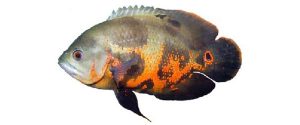
Range: throughout Brazil
Characteristics: Coloration varies, with some specimens showing a tail spot characteristic of other cichlids. Grows to 20 inches and 3 pounds. Breeding pairs protect young by taking them into their mouths. Valued as an aquarium fish.
Diet: small fish, insects, fruits, crustaceans
Habitat: in lakes and slow-moving rivers, prefers areas with aquatic vegetation
Tackle: light rods and 6- to 12-lb line; poppers, spinners, spoons, small plugs
Giant Trahira (Hoplias lacerdae)
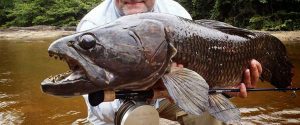
Looking like a prehistoric monster, the giant trahira ranges throughout the Amazon and Tocantins river basins but is not found in all the rivers in these systems. The log-shaped body is dark gray to reddish brown, and the large mouth is lined with conical teeth. Trahira prefer shallow, slow water and rocky areas that facilitate ambushing prey. They can grow to 40 pounds. The Von den Steinen River has recently become known as a reliable producer of giant trahira for sport fishermen. Not only is the river’s rocky bed ideal for trahira, it has been designated as a catch-and-release only area, protecting these predators. Use medium-heavy casting gear and 20- to 30-pound line to work diving and surface lures. Propeller-type topwater lures work especially well, and don’t forget the steel leader. Natural baits such as whole fish or chunks on 8/0 hooks also tempt giant trahira.
FISHING IN THE PANTANAL – PARAGUAY RIVER
Brazil’s Pantanal region, formed by the Rio Paraguai’s extensive watershed, defines the planet’s largest flood plain and covers about 230,000 square kilometers in the states of Mato Grosso and Mato Grosso do Sul. Vegetation creates a veritable mosaic of forests, fields and scrub-covered ridges interspersed with marshes, rivers, sloughs and bays. The rich and diverse fauna includes 230 different species of fish, 650 types of birds, 80 kinds of mammals and 50 different species of reptiles. Biologists consider this area the world’s densest concentration of animal life. Temperatures typically range from 75 to more than 100 degrees Farenheit.
The waters of Pantanal support a complex web of ichthyologic fauna. The list of native game fish includes Dourado, Sorubim, Pacu, Jau, Piraputanga and others; species such as Jacunda, Oscar and Peacock Bass have been introduced in some areas to offer even more options to sport fishermen.
Dorado (Salminus maxillosus) Dourado
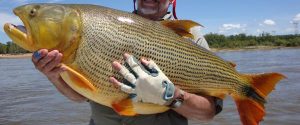
Range: Sao Francisco, Prata and Paraguay river basins
Characteristics: Shaped like a heavy trout, grows to more than 40 pounds. Strong jaws lined with conical teeth, yellow/gold body accented with horizontal black stripes and a black band in the middle of the orange tail. A strong fighter that jumps frequently when hooked. One of Brazil’s most coveted game fish.
The Dorado enchants anglers with its singular beauty and especially with its stubborn, acrobatic fight when hooked. Dorado become easier to locate when river levels drop and schools of the predators are seen attacking baitfish. In these circumstances, dorado will strike natural baits or artificials. The two preferred methods of fishing are casting artificials or drifting with natural baits. The golden dorado typically average 4 to 10 pounds.
Diet: small fish
Habitat: free-flowing rivers, prefers heads of rapids and mouths of feeder creeks
Tackle: medium to medium-heavy rods and 12- to 30-lb line; shallow-diving plugs and spoons; size 5/0 to 7/0 hooks on wire leaders and live baits.
Piraputanga (Brycon microleps)
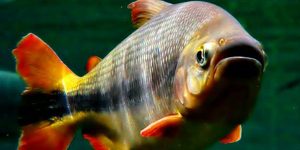
Range: Prata and Sao Francisco river basins
Characteristics: Chrome-colored body with orange fins, small mouth and strong teeth. Can grow to more than 2 feet and 7 pounds. Valued for its tasty flesh, and prized by sport fishermen for its willingness to strike flies and lures.
Diet: small fish, fruits and seeds
Habitat: prefers clear-water rivers, where it hides near structures such as fallen trees and rocks
Tackle: light to medium rods and 12- to 20-lb line; spoons, spinners, surface or diving plugs; size 1/0 to 3/0 hooks baited with fruit or small fish; wire leaders
Although it rarely surpasses 20 inches, the piraputanga puts up an admirable fight, making strong runs and repeated leaps. It prefers stretches of the river with clear, fast-running water.
Payara (Hydrolicus scomberoides) Cachorra Facão
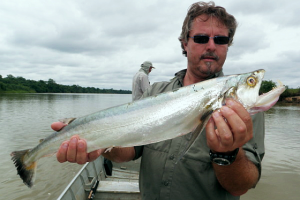
Range: Amazon and Paraguay river basins
Characteristics: Known as cachorra (dogfish) in Brazil, the payara prefers fast-moving stretches of rivers throughout the Amazon and Paraguay river watersheds. The elongated, compressed body is dark blue or greenish along the back, brightening to silver sides and white belly. Easily identified by a pair of long fangs in the lower jaw, payara are voracious predators that attack artificial lures and jump often when hooked.
Diet: small fish
Habitat: deep, fast-flowing stretches of rivers; tails of rapids
Tackle: medium or medium-heavy rods; 12- to 25-lb line; diving plugs, spoons, jigs; wire leaders necessary
Piauçu (Leporinus macrocephalus)
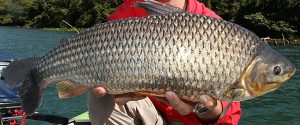
Range: Prata and Paraguay river basins
Characteristics: Resembles a carp, with large scales and rotund body, coloration varies from gray to reddish. Can exceed 2 feet and 12 pounds, with tasty flesh.
Diet: crustaceans, mollusks and fruits
Habitat: bays and flooded fields, prefers areas with floating vegetation
Tackle: medium rods and 12- to 16-lb line; 4/0 to 6/0 hooks baited with crabs, snails, corn or doughballs
Peacock Bass
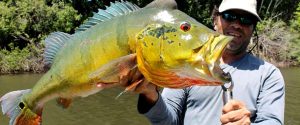
A native of the Araguaia River watershed, the blue peacock bass was accidentally introduced to the Piqueri about 20 years ago. It has adapted well to the river’s many bays and backwaters, and is now one of the area’s main attractions. Peacocks are found in the bays and among structure along the main river channel, where they reach an average size of 5 pounds.
Sorubim (Pseudoplatystoma corruscans) Pintado
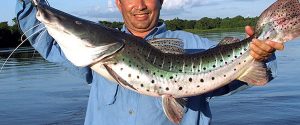
Range: Sao Francisco and Prata river basins
Characteristics: Flat-headed catfish that can reach more than four feet and 150 pounds. Dark gray back, white flanks covered with black spots and markings. Valued as both a hard-fighting sport fish and excellent table fare.
Diet: small fish
Habitat: flooded fields during high-water season, deep pools and undercut banks
Tackle: heavy rods and 40-lb line or heavier; 8/0 to 10/0 hooks baited with small fish or large worms
Spotted and striped sorubim catfish prefer deep holes, the outflows of bays and river banks lined with floating vegetation. Angling success usually comes with live baits such as eels and small fish. You can catch sorubim while tied off to the shore or while drifting. These catfish can reach 30 pounds or so.
Pacu (Piaractus mesopotamicus)
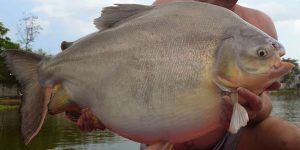
Range: Amazon, Araguaia and Prata river basins
Characteristics: Plate-shaped body, small head and mouth lined with human-like molars used to crush crabs and seeds. Coloration varies from dark olive or gray to yellowish, can grow to over 3 feet and weigh more than 25 pounds. Valued as a sport and food fish.
Diet: pacu are called “river pigs” because they eat nearly anything, but prefer fruits, seeds and crabs
Habitat: invades flooded fields during high-water season, prefers areas with floating vegetation or stays near overhanging fruit-bearing trees
Tackle: medium-heavy rods and 16- to 30-lb line; size 4/0 to 6/0 short-shank hooks and crabs for bait; can also use bamboo poles with 80-lb line and hooks baited with palm fruits, letting the bait splash into the water to attract fish
A favorite among Brazilian anglers, this vegetarian cousin of the piranha makes mighty fine eating. It prefers bays and quieter waters but sometimes is found in the river proper. Best baits include locally available fruits and freshwater crabs. Pacu range from 2 to 10 pounds.
Jau (Paulicea luetkeni)
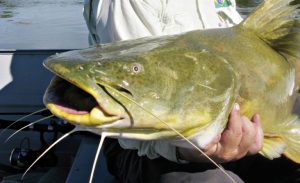
Range: Amazon and Prata river basins
Characteristics: Catfish with large head and relatively short, rotund body. Coloration varies with location, ranging from brown to yellowish to greenish. Grows to 5 feet and can exceed 200 pounds. Very large specimens are increasingly hard to find in Pantanal but still occur with frequency in the Telles Pires and Juruena rivers.
Diet: small fish
Habitat: deep pools, especially those at the base of waterfalls
Tackle: Stout rods and 50-lb or heavier line; hooks from 8/0 to 12/0 and heavy sinkers to keep baits on the bottom in deep water
The largest catfish in Pantanal, the jau can grow to more than 150 pounds, but typically ranges from 20 to 50. It inhabits the deepest holes in the river, waiting for easy meals to swim by. Natural baits are called for to catch jau.
Flatwhiskered Catfish (Pinirampus pinirampu) Barbado
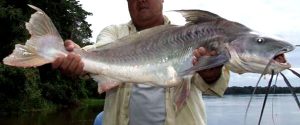
Range: Amazon and Paraguay river basins
Characteristics: This catfish exhibits a set of very long whiskers and an overall gray coloration, can grow to more than 30 inches and weigh 20 pounds.
Diet: small fish
Habitat: deeper stretches of rivers
Tackle: medium to heavy rods and 20- to 30-lb line; size 5/0 to 8/0 hooks and sinkers to keep natural bait on bottom.
